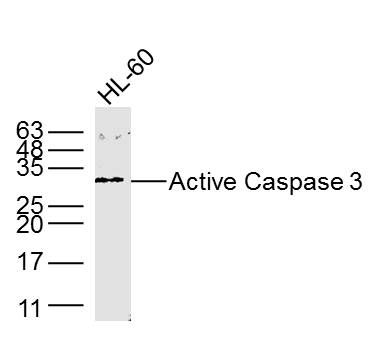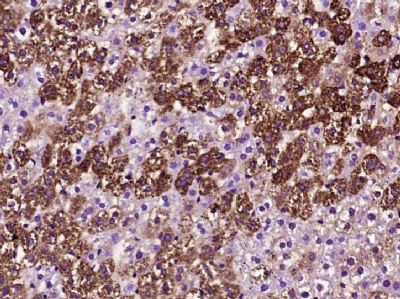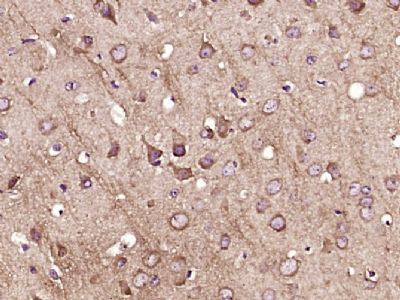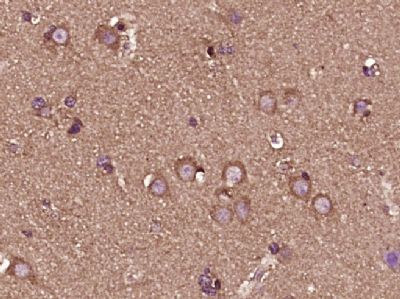[IF=2.303] Suihui Li. et al. Hsa_circ_0048674 facilitates hepatocellular carcinoma progression and natural killer cell exhaustion depending on the regulation of miR-223-3p/PDL1. Histol Histopathol. 2022 Feb 21;1888 WB ; Human.
[IF=3.067] Kang Z et al. Copper-induced apoptosis and autophagy through oxidative stress-mediated mitochondrial dysfunction in male germ cells. Toxicol In Vitro. 2019 Sep 3;61:104639. WB ; Mouse.
[IF=4.375] Qiu Lei. et al. MiR-526b-3p Inhibits the Resistance of Glioma Cells to Adriamycin by Targeting MAPRE1. J Oncol. 2022;2022:482212 WB ; Human.
[IF=4.872] Xuanxuan Jiang. et al. Arsenic (III) and/or Antimony (III) induced disruption of calcium homeostasis and endoplasmic reticulum stress resulting in apoptosis in mice heart. Ecotox Environ Safe. 2021 Sep;220:112394 WB ; Mouse.
[IF=4.872] Shaofeng Wu. et al. Protective effects of curcumin on ATO-induced nephrotoxicity in ducks in relation to suppressed autophagy, apoptosis and dyslipidemia by regulating oxidative stress. Ecotox Environ Safe. 2021 Aug;219:112350 WB ; Duck.
[IF=4.486] Mingying Han. et al. Verapamil inhibits early acute liver failure through suppressing the NLRP3 inflammasome pathway. 2021 May 24 WB ; Mouse.
[IF=2.795] Ying Feng. et al. LncRNA MALAT1 inhibits apoptosis of endometrial stromal cells through miR-126-5p-CREB1 axis by activating PI3K-AKT pathway. Mol Cell Biochem. 2020 Dec;475(1):185-194 WB ; Human.
[IF=2.1] Xing Xue. et al. Effects of local dexmedetomidine administration on the neurotoxicity of ropivacaine for sciatic nerve block in rats. Mol Med Rep. 2020 Nov;22(5):472-4366 WB ; Rat.
[IF=2.314] Che H et al. circ_0080145 Enhances Imatinib Resistance of Chronic Myeloid Leukemia by Regulating miR-326/PPFIA1 Axis. Cancer Biother Radiopharm. 2020 Jun 27. WB ; Human.
[IF=3.585] Sha J et al. Dexmedetomidine attenuates lipopolysaccharide-induced liver oxidative stress and cell apoptosis in rats by increasing GSK-3β/MKP-1/Nrf2 pathway activity via the α2 adrenergic receptor. Toxicol Appl Pharmacol. 2019 Feb 1;364:144-152. WB ; Rat.
[IF=1.664] Peng et al. Overexpressing modified human TRβ1 suppresses the proliferation of breast cancer MDA-MB-468 cells. (2018) Oncol.Lett. 16:785-792 WB ; Human.
[IF=3.813] Hongwei Duan. et al. Dihydrotestosterone regulates oestrogen secretion, oestrogen receptor expression, and apoptosis in granulosa cells during antral follicle development. J Steroid Biochem. 2021 Mar;207:105819 WB ; Sheep.
[IF=2.314] Hong Cheet al. circ_0080145 Enhances Imatinib Resistance of Chronic Myeloid Leukemia by Regulating miR-326/PPFIA1 Axis. Cancer Biother Radiopharm
. 2020 Jun 27. WB ; Human.
[IF=1.445] Li YH et al. Neuroprotective Effect of Fructus broussonetiae on APP/PS1 Mice via Upregulation of AKT/β-Catenin Signaling. Chin J Integr Med. 2020 Jan 4. WB ; Mouse&Rat.
[IF=1.664] Wang QM et al. MMP-1 is overexpressed in triple‑negative breast cancer tissues and the knockdown of MMP‑1 expression inhibits tumor cell malignant behaviors in vitro. ONCOLOGY LETTERS 17: 1732-1740, 2019. WB ; Human.
[IF=1.935] Ou X et al. Desumoylating Isopeptidase 2 (DESI2) Inhibits Proliferation and Promotes Apoptosis of Pancreatic Cancer Cells through Regulating PI3K/AKT/mTOR Signaling Pathway. (2018)Pathol. Oncol. Res. Nov 8. WB ; Human.



